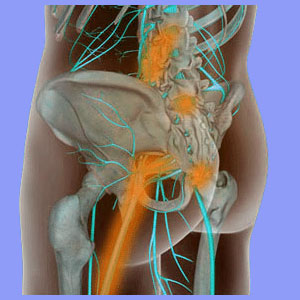
Is ultrasound for sciatica a good pain management practice? Sure, ultrasound can be useful for many diagnostic purposes within the human anatomy, but how to does it fare when used as a pain reduction therapy?
Ultrasound treatment has some great upsides when it comes to treating sciatica. However, it also has some downsides that are rarely discussed with patients prior to getting them involved in the treatment. The goal of this discussion is to provide a complete and objective view of ultrasound when used as a pain management practice for sciatica patients in a professional setting.
What is Ultrasound for Sciatica?
Ultrasound is a high frequency wave technology that is primarily used to image parts of the internal anatomy. Sound waves echo off anatomical structures and provide rudimentary images of these structures. In this respect, ultrasound is one of the easiest, most inexpensive and safest of all diagnostic imaging technologies.
Ultrasound can also be used for therapeutic applications, as well, such as in the case of using it to actually treat sciatica. In this application, the high frequency sound waves are directed at the suspected source of sciatica, as well as the path of pain that traverses the nerve. Treatment is most commonly offered by chiropractors, physical therapists, sports medicine specialists and rehabilitation medical providers, although any qualified healthcare professional may offer pain management services.
Ultrasound Benefits
Let’s explore some of the better points of ultrasound pain management treatment for sciatic nerve symptoms:
Ultrasound therapy is widely considered to be safe. It is noninvasive and there are no real hazards involved with the treatment.
Ultrasound is easy to use for care providers and technicians can be trained quickly to free up a doctor’s time for other matters.
Ultrasound equipment is not outrageously expensive like many medical technologies, making the treatment practical for smaller medical offices and complementary care providers.
Ultrasound is economical for the patient and is most often covered by major health insurance plans.
Ultrasound may provide some tangible pain management benefits with little risk or side effects. Therapy is also nonpharmaceutical and nonsurgical. There are very few contraindicating conditions for receiving ultrasound therapy.
Ultrasound for Sciatica Downsides
There are certainly some important negative aspects of using ultrasound to treat sciatica, as well:
The primary downside is very limited proof of efficacy of the therapy. Most positive results are conservative and virtually identical to outcomes offered by placebo therapy. Studies have not produced the type of conclusive proof of efficacy that allow ultrasound to be universally accepted as a legitimate pain therapy.
The therapy, like many of its type (TENS, chiropractic, etc), can be used as a financial exploitation tool of patients. Ultrasound is often part of a combined care approach to sciatica treatment and this approach is often associated with injury mills, insurance billing scams and other messy situations. This is NOT to say that ultrasound is a scam! It is just a warning that it is often used more for financial gain of the care provider than for the true benefit to the recipient.
In summary, if you are open-minded to alternative therapies and really want to avoid invasive and pharmacological treatments, then ultrasound is certainly worth a try. You have little to lose and if relief is provided, then it is worth the time and effort to find a qualified care provider and give the therapy a chance.





